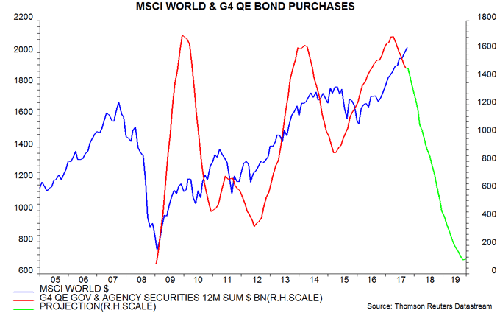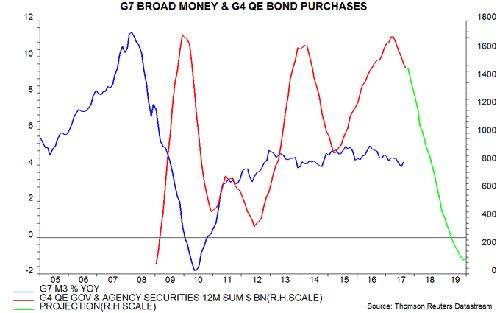
Janus Henderson: QE slowdown clouding 2018 economic

Slowing QE may put downward pressure on the velocity of circulation of broad money in 2018, with negative implications for the economy and risk markets.
25.10.2017 | 09:12 Uhr
The 12-month rolling total of purchases of government and agency securities by the Fed, BoJ, ECB and Bank of England peaked at nearly $1.7 trillion in April 2017 and is projected to halve by mid-2018 – see first chart(*). (*The projection is based on Fed QE reversal plans, open-ended BoJ purchases of ¥5 trillion per month (i.e. close to the average over the 12 months to September), a final round of ECB QE of €25 billion per month over January-September 2018 and no purchases / sales by the Bank of England. Transactions in corporate securities are excluded.)

Previous falls in the 12-month rolling total from peaks in December 2009, June 2011 and March 2014 were followed by significant declines in world equities starting 16, nine and 14 months later respectively – first chart.
Some monetarist economists claim that QE fluctuations have affected the economy and markets by changing the growth rate of broad money M3. The evidence does not support this claim. The initial burst of QE in 2009-10 was associated with a recovery in G7 M3 growth in 2010-11 but subsequent rounds appear to have had little impact – second chart.

QE, instead, may have mainly affected confidence / risk appetite and the velocity of circulation, rather than money growth directly. The annual rate of change of a monthly measure of broad money velocity, i.e. the product of industrial output and consumer prices divided by M3, rose after each of the three big QE surges – third chart.

The prospective QE slowdown, therefore, suggests renewed downward pressure on velocity in 2018. Unless broad money growth rises to compensate, this would imply lower nominal economic expansion and, probably, weaker markets.
Broad money trends are currently stable: G7 annual M3 growth is lower than a year ago but within its post-2012 range – second chart.
The forecasting approach here emphasises narrow rather than broad money. The demand to hold narrow money is closely related to spending intentions, so narrow money trends should capture shifts in confidence / risk appetite and associated changes in broad money velocity. Global real narrow money growth has moderated recently, suggesting slower economic expansion in 2018 than 2017 – see previous post.



Diesen Beitrag teilen: